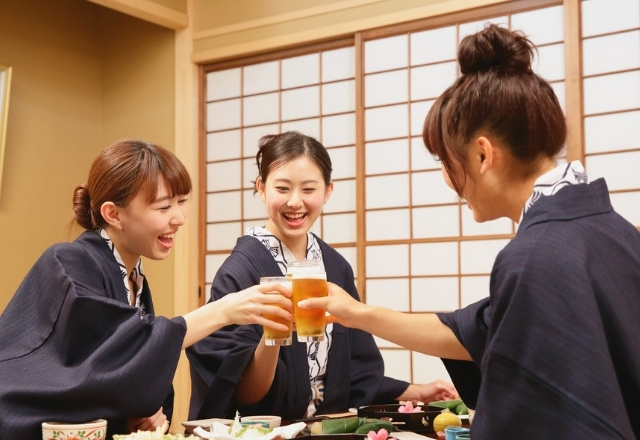What is an Onsen?
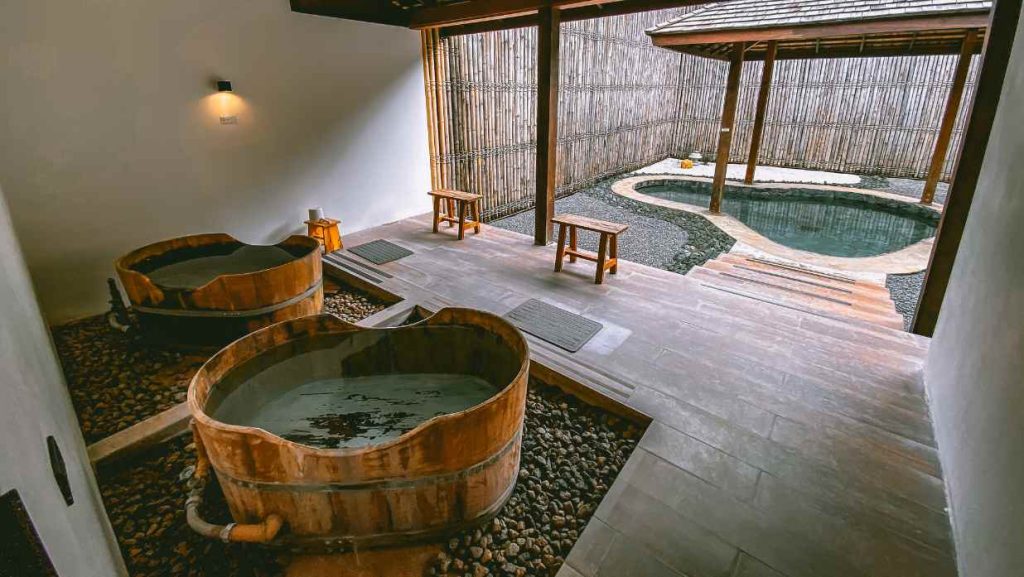
An onsen (温泉) is a Japanese hot spring, naturally heated by geothermal activity. These mineral-rich waters are found all across Japan, a country known for its volcanic landscape. Beyond being a simple bath, visiting an onsen is a cultural experience deeply rooted in Japanese tradition.
While onsen are often confused with sento (public baths), the key difference lies in the water source:
- Onsen use natural thermal spring water, often containing minerals believed to have health benefits.
- Sento use regular tap water that is heated artificially and may be mixed with additives.
Onsen have existed in Japan for centuries, with early records showing their use by samurai and monks for healing, purification, and spiritual cleansing. Today, they remain an integral part of Japanese life, from urban spa resorts to remote outdoor baths in the mountains.
Anecdote:
The famous warlord Takeda Shingen (16th century) is said to have built an outdoor bath near a battlefield so his injured soldiers could heal faster in the hot spring waters. This onsen still exists today in Yamanashi Prefecture!
💡 Did you know?
To be officially classified as an onsen in Japan, the water must come from at least 1,000 meters underground and contain specific minerals like sulfur, iron, or carbon dioxide. Not all hot baths qualify!
Why Are Onsen So Popular in Japan?
Onsen are more than just a place to wash, they are a ritual of relaxation, a moment of pause in a fast-paced society. Here’s why they’re beloved across generations:
- Physical health: Onsen water is believed to help with muscle pain, skin conditions, circulation, and fatigue. Depending on the minerals present, each spring may offer different therapeutic benefits.
- Mental well-being: The quiet, minimalist setting of onsen resorts provides a much-needed escape from city noise and daily stress.
- Social connection: Families, friends, and even coworkers often visit onsen together. Bathing communally, without distractions, encourages open conversation and bonding.
- Cultural heritage: From samurai legends to anime scenes, onsen are embedded in Japan’s national identity. Visiting an onsen is often part of New Year trips, seasonal retreats, or coming-of-age journeys.
Whether you’re traveling solo or with friends, slipping into an onsen is a quintessential Japanese experience, and one you’ll likely never forget.
Onsen Etiquette: What You Need to Know Before You Bathe
Visiting an onsen for the first time can feel a bit intimidating, but don’t worry! Japanese bathing culture follows a clear set of rules to ensure hygiene, comfort, and respect for others. Here’s a breakdown of the essentials:
Do’s
- Wash thoroughly before entering the bath: Use the shower area to scrub your body with soap and rinse off all suds. This step is essential.
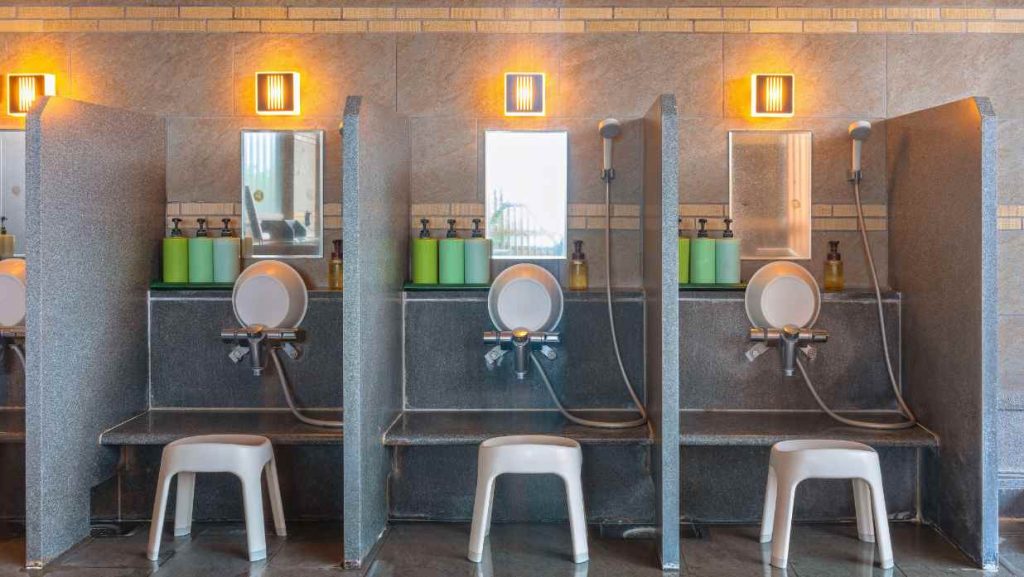
- Tie up your hair: If you have long hair, tie it in a bun to keep it out of the water.
- Use a small towel modestly: You can bring a hand towel to the edge of the bath, but never let it touch the water. Most people fold it and place it on their head.
- Be quiet and mindful: Keep conversations low and avoid splashing.
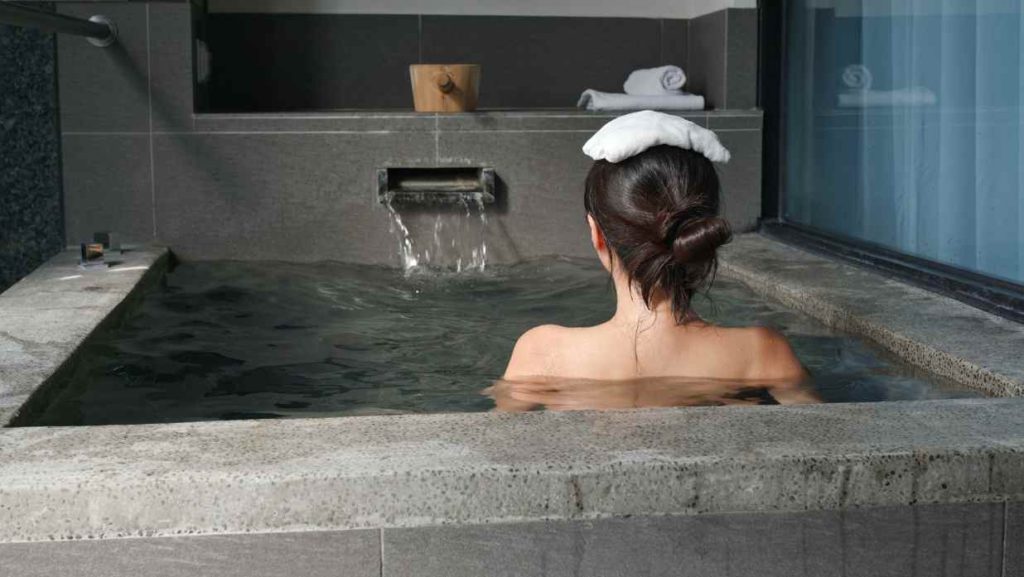
Don’ts
- No swimsuits or clothes allowed: Onsen bathing is done nude, separated by gender in most cases.
- No diving, swimming, or excessive movement: It’s not a pool, just relax and soak.
- Don’t bring your phone or camera: Onsen are for disconnecting. Plus, privacy is extremely important.
- Don’t enter while still soapy: Always rinse off all soap and shampoo before soaking.
⚠️ Tattoos: A Cultural Note
In Japan, tattoos are traditionally associated with the yakuza (organized crime), so many onsen do not allow guests with tattoos. However, this is slowly changing. Some onsen now:
- Accept tattoos if they’re small and can be covered with a patch,
- Offer private baths (貸切風呂, kashikiri buro),
- Are openly tattoo-friendly, especially in tourist areas.
We’ll highlight some of those in our best onsen list later in this blog.
Where Do Onsen Come From and Why Are They So Special?
Japan’s incredible onsen culture is rooted in its unique geology. With over 100 active volcanoes and abundant geothermal activity, Japan is home to more than 3,000 natural hot springs, more than almost any other country in the world.
Onsen water is naturally heated by the Earth, sometimes reaching the surface at temperatures well above 40°C. But what makes it truly special is the mineral content: each onsen has its own unique mix of elements like sulfur, iron, radium, or carbon dioxide, believed to offer various health benefits.
Types of Onsen Water (yu-no-shurui) ♨️
- Sulfur Springs (硫黄泉, iō-sen): Often milky white, said to help skin conditions and joint pain.
- Iron Springs (鉄泉, tetsu-sen): Reddish brown, known to warm the body and improve circulation.
- Carbonated Springs (炭酸泉, tansan-sen): Fizzy and gentle, said to help with blood pressure.
- Acidic Springs (酸性泉, sansei-sen): Strongly antibacterial, popular for skin cleansing.
💡 Did You Know?
Some onsen are drinkable!
That’s right, at certain hot springs like Kusatsu Onsen, you’ll find people sipping small cups of hot spring water believed to aid digestion. (We don’t recommend trying it unless the sign says it’s safe!)When Is the Best Time to Visit a Japanese Onsen ?
While onsen can be enjoyed year-round, each season offers its own charm, and your experience will vary depending on when you go.
❄️ Winter (December–February): The Ultimate Onsen Season
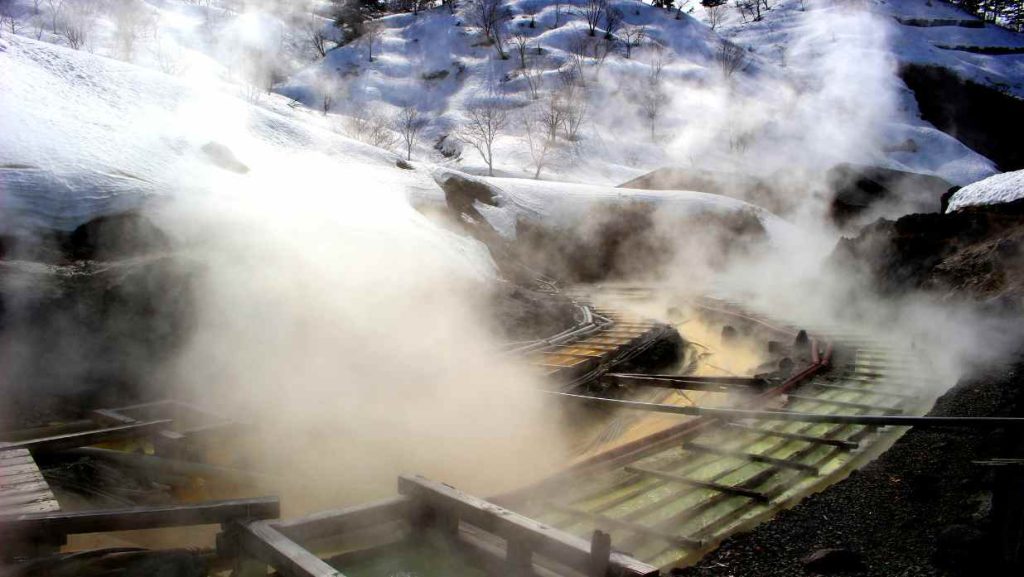
If you’ve seen pictures of people soaking in steaming baths surrounded by snow-covered landscapes, that’s the magic of winter. This is the most iconic and popular season for onsen, especially in mountain regions like Nagano or Tohoku. The contrast between the cold air and the hot water creates an unforgettable experience.
🍁 Autumn (October–November): For the Fall Foliage
Imagine bathing outdoors as crimson maple leaves float on the water. Autumn is a calm and colorful time to visit, especially if you enjoy koyo (autumn leaf viewing). Onsen towns in Nikko, Hakone, or Oita are particularly beautiful during this season.
🌸 Spring (March–May): Cherry Blossoms & Mild Weather
With blooming sakura trees and mild temperatures, spring is perfect for outdoor onsen (rotenburo). Some resorts even offer petal-filled baths, where you can soak surrounded by falling blossoms, a dreamlike experience.
🌞 Summer (June–August): Off-Peak and Relaxed
Although less popular due to the heat, summer can still be a great time to visit mountainous or coastal onsen resorts where temperatures are cooler. It’s also the off-season in many areas, meaning fewer crowds and lower prices.
Habits & Culture After the Bath
Visiting a Japanese onsen doesn’t end when you step out of the bath, there’s a whole culture of relaxation and ritual that continues afterwards. These small customs are an essential part of the full onsen experience in Japan.
A Cold Bottle of Milk (or Coffee Milk)
It’s almost a tradition: after soaking in an onsen, many people head straight to the vending machines or lobby fridge for a cold bottle of milk, especially coffee milk (コーヒー牛乳) or fruit milk (フルーツ牛乳). Standing with one hand on your hip while chugging it in one go? That’s the proper onsen style!
Or Maybe… a Beer!
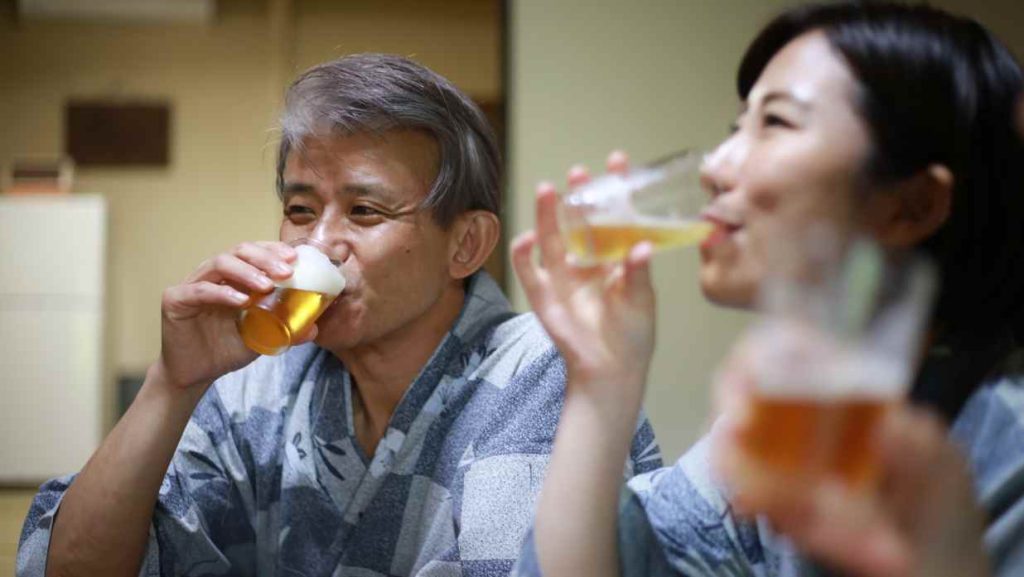
If you’re in a ryokan or onsen town, having a cold draft beer after your bath is another beloved way to unwind. Some outdoor bathhouses even sell drinks nearby so you can enjoy them on the spot. It’s the ultimate way to say, “I’ve earned this.”
Relax in a Yukata
After bathing, guests at onsen ryokan typically put on a yukata, a light cotton kimono provided by the inn. It’s comfortable, cool, and perfect for strolling around the town, lounging in the tatami room, or heading to dinner. You’ll often see entire towns of people walking in yukata, it’s all part of the atmosphere.
Time to Nap or Dine
A good soak makes you sleepy, in the best way. After bathing, many people relax in the tatami-floored rest area, enjoy a traditional meal (kaiseki), or even take a nap. In fact, onsen time often sets the rhythm of a whole day in Japanese leisure culture: bath, eat, relax, repeat.
Top Onsen Spots in Japan
Japan is blessed with thousands of natural hot springs, but a few regions stand out as truly iconic onsen destinations. Whether you’re looking for snowy mountain views, oceanside baths, or tattoo-friendly experiences, here are some of the top onsen areas you shouldn’t miss:
Kusatsu Onsen (Gunma)
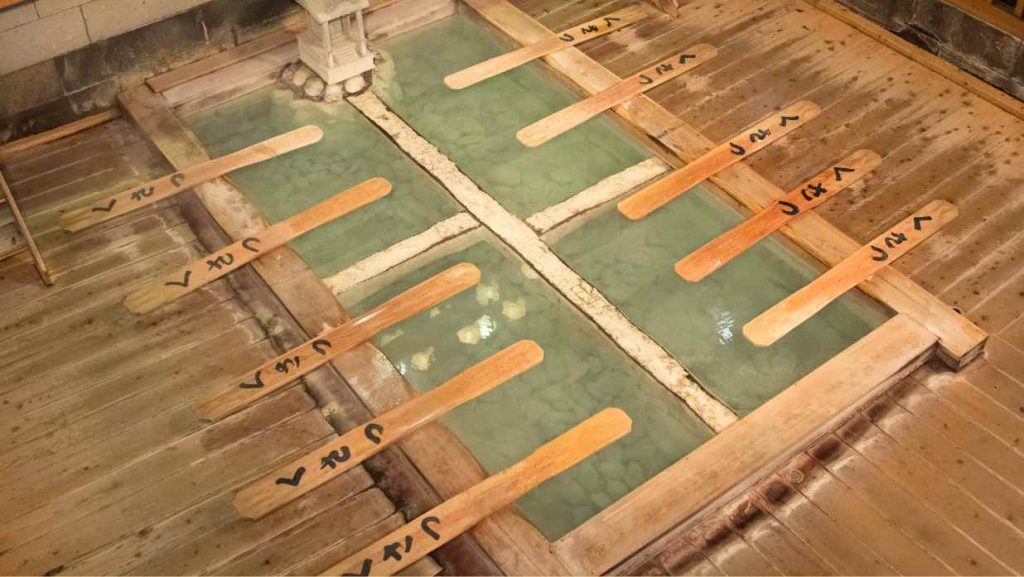
Often ranked as Japan’s top onsen town, Kusatsu is famous for its highly acidic waters believed to cure all manner of ailments. Don’t miss the dramatic Yubatake (hot water field) in the town center.
- Tattoo policy: Many baths restrict tattoos, but private rentals are available.
- Don’t miss: Yumomi performance, where locals stir the water with giant paddles.
Hakone (Kanagawa)
Just a short trip from Tokyo, Hakone offers luxurious ryokan, mountain scenery, and even views of Mt. Fuji from some baths.
- Tattoo policy: Varies by facility. Many ryokan offer private baths for tattooed guests.
- Don’t miss: Open-air onsen with lake views.
Beppu & Yufuin (Oita, Kyushu)
Beppu is known for its steaming “hells” (jigoku) and the largest variety of onsen types in Japan. Nearby Yufuin is more upscale and relaxed.
- Tattoo policy: More flexible, especially in mixed sand and mud baths.
- Don’t miss: Sand baths, mud baths, and steam cooking.
Kinosaki Onsen (Hyogo)
This charming town is designed for on-the-go onsen hopping, walk around in a yukata and visit seven public bathhouses, each with its own style.
- Tattoo policy: Generally accepted in public baths.
- Don’t miss: Willow-lined canals and old-timey streets.
Ibusuki (Kagoshima)
Famous for its sunamushi (hot sand baths), where you’re buried up to the neck in naturally heated sand.
- Tattoo policy: Typically OK in sand baths.
- Don’t miss: The unique sensation of sand therapy!
Bokyo no Yu (Tochigi)
Located near the scenic Oze National Park, Bokyo no Yu is not only tattoo-friendly, but also offers a peaceful, rural escape, perfect after a hike.
- Tattoo policy: Accepted
- Don’t miss: Outdoor rotenburo with mountain views.
Day-Use vs. Overnight Onsen: What’s the Difference?
When planning a visit to a Japanese onsen, one of the first things to decide is whether you want to go just for the day, or turn your visit into a full-blown getaway with an overnight stay.
Day-Use Japanese Onsen (Higaeri Onsen)
Perfect for a quick soak, day-use onsen (日帰り温泉 / higaeri onsen) are facilities that allow guests to enjoy the baths without staying overnight.
- Pros:
- Affordable (entry fees typically range from ¥500 to ¥1,500)
- Great for travelers on tight schedules
- Many public onsen towns have several you can hop between
- Cons:
- No private rooms or meals included
- Limited relaxation time
Tip: Some higaeri onsen have rotenburo (outdoor baths) with stunning views, you don’t need to stay overnight to enjoy something magical.
Ryokan or Onsen Hotels (Overnight Stay)
Staying overnight at a ryokan (traditional inn) or an onsen hotel offers a more immersive and luxurious experience.
- Pros:
- Includes accommodation and meals (often elaborate kaiseki dinners)
- Access to the baths multiple times, even late at night or early morning
- Yukata robes and tatami rooms enhance the traditional experience
- Cons:
- More expensive (typically starts around ¥10,000–¥25,000+ per night)
- Needs to be booked in advance, especially during weekends or holidays
Best of both worlds: Some ryokan also allow day-use bathers during the day, then close off the baths to overnight guests in the evening.
Conclusion
Whether you’re seeking to relax after a long day of sightseeing or experience a unique slice of Japanese culture, visiting an onsen is a must-do in Japan. From tranquil mountain springs to stylish onsen towns and luxurious ryokan, there’s a soak for everyone, tattooed or not. Embrace the heat, savor the silence, and don’t forget to grab a cold bottle of milk after your dip!
Love what you are reading? Come to Japan on an exciting study-abroad journey!
If you love Japanese culture, why not study Japanese in Japan? Coto is excited to announce that we’re offering a matching service to help students find a Japanese language school that provides student visas.
So if you want to come to Japan, let us help you! We provide free support, no agent fee! Our goal is to help make your dream of moving to Japan come true. Find a language school today and contact us!
FAQ
Do I have to be completely naked in an onsen?
Yes. Swimsuits and underwear are not allowed. Everyone bathes nude, but don’t worry, people are generally respectful and mind their own business.
Can I visit an onsen if I have tattoos?
Some onsen still restrict tattoos due to associations with organized crime, but many modern or foreigner-friendly spots now welcome tattooed visitors, especially those with private baths or designated tattoo-OK areas.
What should I bring to an onsen?
Most onsen provide towels, soap, and shampoo, but it’s good to bring your own small towel for modesty and drying off afterward. Bring a change of clothes if you’re just visiting for the day.
What’s the best season to enjoy an onsen?
Winter is often considered the most magical time, soaking in a steaming rotenburo while snow falls around you is unforgettable. But every season has its charm!




